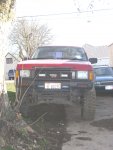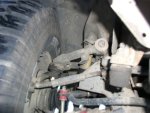winkosmosis
Explorer
I was walking by a previous generation Frontier yesterday and the wheels were turned so I could see the suspension arms. It was one of the models with a taller than normal suspension.
The angles of the control arms was really weird. The downward angle of the UCA was actually steeper than the LCA! This would mean that as the suspension compresses, the tire tilts outward. That's the opposite of what should happen-- the tire lean into the turn like a motorcycle, stay perpendicular to the road (like with a solid axle), or at least stay more perpendicular than the vehicle (most IFS).
With this design, the proper camber change doesn't happen during suspension cycling until after the arms reach the horizontal position.
I thought it must be an optical illusion, but then I realized that Nissan lift kits include longer UCAs, which would match the geometry I saw.
The only explanation I can think of is that in the original OEM design, both upper and lower arms are parallel to the ground, so when you (or Nissan) cranks the torsion bars the shorter UCA is forced to angle downward more and pull the top of the tire in. So you (or Nissan) replace it with a longer arm but you're still left with the same geometry issue.
Why did Nissan design their IFS this way, especially considering they themselves sell vehicles with "lifts"? The solution would be to have the frame mounts closer to each other than the knuckle mounts, so that no matter what the tire will gain positive camber as it moves down (or when you lift) and negative camber as it moves up (when the suspension compresses).
The angles of the control arms was really weird. The downward angle of the UCA was actually steeper than the LCA! This would mean that as the suspension compresses, the tire tilts outward. That's the opposite of what should happen-- the tire lean into the turn like a motorcycle, stay perpendicular to the road (like with a solid axle), or at least stay more perpendicular than the vehicle (most IFS).
With this design, the proper camber change doesn't happen during suspension cycling until after the arms reach the horizontal position.
I thought it must be an optical illusion, but then I realized that Nissan lift kits include longer UCAs, which would match the geometry I saw.
The only explanation I can think of is that in the original OEM design, both upper and lower arms are parallel to the ground, so when you (or Nissan) cranks the torsion bars the shorter UCA is forced to angle downward more and pull the top of the tire in. So you (or Nissan) replace it with a longer arm but you're still left with the same geometry issue.
Why did Nissan design their IFS this way, especially considering they themselves sell vehicles with "lifts"? The solution would be to have the frame mounts closer to each other than the knuckle mounts, so that no matter what the tire will gain positive camber as it moves down (or when you lift) and negative camber as it moves up (when the suspension compresses).



